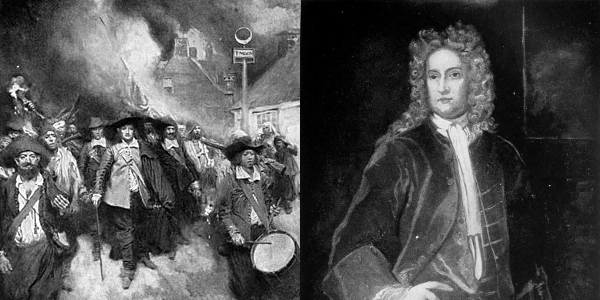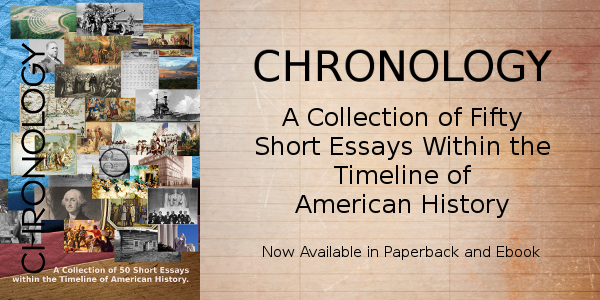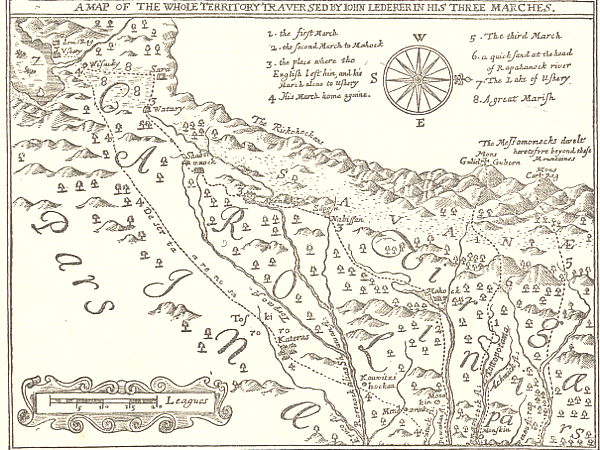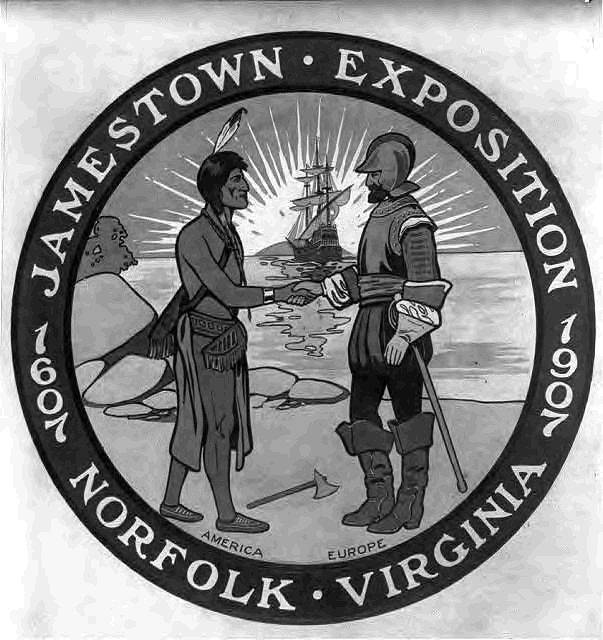Sponsor this page for your business, school, or personal needs. Your banner or text ad can fill the space above.
Click here to Sponsor the page and how to reserve your ad.
-
Timeline
1676 Detail
September 19, 1676 - Bacon's Rebellion causes the burning of Jamestown. Nathaniel Bacon leads the rebellion of planters against Governor Berkeley. Bacon would perish and twenty-three others were executed.

The Jamestown settlement had been struggling, and prospering, since their arrival in 1607. Nothing had taken them down. Not the capture of John Smith and his saving by Pocahontas. Not the three wars with the Powhatan Confederacy. Not the starvation and deprivation. There had been successes such as the House of Burgesses and the expansion of their territory and plantations beyond the city. There had been defeats, not only in battle, but in the allowance of slavery to enter British America in 1619. But they had survived. That is, until Bacon's Rebellion hit the city, destroyed a good portion of it, and essentially, never truly allowed it to recover to its same glory as other towns grew.
It had been thirty years since the problem with the Powhatan Confederacy had effectively been dealt with after the colonial victory in 1646. The settlement and the plantations around it were prospering, although continuing to encroach onto Northern Neck land claimed by the tribes that remained; Secocowon, Doeg, Patawomeck and Rappahannock. However, Sir William Berkeley was a veteran of all the Jamestown struggles, a favorite of the King, scholar, and tough old bird. He was well respected by most. He had a cousin by marriage, Nathaniel Bacon, Jr., who had been an immature troublemaker in Europe and sent to Jamestown by his father to mature. He did not, disdained labor, but was intelligent. Berkeley gave him a seat on the Jamestown council in 1675, a substantial land grant, and treated him with respect.
At the same time, the colony was starting to have problems. Tobacco prices were dropping, the competition from the colonies in Maryland and the Carolinas was eating into their profits, and the weather was terrible. In England, they were having trouble in their naval wars with the Dutch. The colonists were getting restless and scapegated their problems on the remnants of the local Indians. In July 1675, the plantation of Thomas Mathews, in the northern neck of Virginia, was attacked by the Doag Indians for nonpayment of goods they had sold him. In retaliation, the colonists attacked the offending Doag, killed ten, and a group of wrong, friendly Indians, the Susquehanaugs, killing fourteen. Large scale Indian raids followed.
Governor Berkeley's Response
To forestall future attacks, Berkeley called a meeting between the colonists and the tribes involved, which turned into a disaster. The colonists killed several tribal chiefs. Berkeley continued to call for restraint, but the colonists, including cousin Bacon, refused, capturing some friendly Appomattox Indians for stealing corn. There began a power struggle within the colonial community; was Berkeley or Bacon right?
The governor continued to take action, taking guns and ammunition from the local Indians, and declaring war on the bad Indians at the "Long Assembly" in March 1676, which was thought corrupt due to the trading practices it ordained. Berkeley set up a strong defensive zone around Virginia and allowed trade with the Indians for his friends, setting up a commission to monitor all trade, and disallowing individual trade amongst regular traders. Bacon was adversely affected. He was also denied a commission to lead a local militia, so Bacon formed his own, wore the title General, and agreed to fund its fights against the Indians. He drove the Pamunkey from their nearby land. Bacon had no love for incorporting even friendly Indians into English society, "Our Design ... to ruin and extirpate all Indians in General," Nathaniel Bacon.
Berkeley was furious at the disrespect. He rode to Bacon's headquarters in Henrico with three hundred men; Bacon fled into the forest with two hundred of his fighters. The Governor thus issued two petitions, denoting that Bacon was a rebel now relieved of his council seat but would be given a fair trial, and that Bacon's fighters would be given amnesty for their activities if they went home peacefully. Bacon attacked the friendly Occaneecheee Indians on the Roanake and stole their beaver pelts instead.
The House of Burgesses demanded that Bacon turn himself in and ask for forgiveness. The colonists responded by electing him to the House of Burgesses, of which he attended the Assembly of June 1676. When he arrived, Berkeley immediately captured him, made to apologize, but then was allowed to take his seat. The House and Berkeley, however, were misreading the situation. Bacon's support amongst the colonists was growing. Bacon stood up in a debate over the Indian problems, left the House of Burgesses, and returned outside the statehouse with his forces, demanding his commission to lead the militia against them.
Berkeley stood his ground and demanded that Bacon shoot him. "Here shoot me before God, fair mark shoot," Governor William Berkeley. Bacon did not shoot. He demanded to be made General of all forces against the Indians, refusing Berkeley's offer of a volunteer commission. Berkeley's denied that generalship, but gave him the right to eventually engage in an Indian campaign without interference. Tensions had been high and threats to the health of several members of the House of Burgesses in the offing.
Minute Walk in History - Bacon's Rebellion
Take a walk in history on the grounds and in the home originally built by Arthur Allen in 1850. It had predominantly been known as Allen's Brick House prior to the rebellion against Governor William Berkeley of Jamestown and the Virginia Colony, led by Nathaniel Bacon in 1676. It was built as a lavish plantation mansion, the oldest standing brick dwelling in the United States. However, when seventy or so men of Bacon's militia occupied the house and used it as a fort during the latter days of the rebellion for three months, Bacon's Castle is what it would be referred to from then on.
Buy Chronology

This effectively gave Nathanial Bacon control of Jamestown from July to September 1676. Sir William Berkeley retired to his home in Green Springs for a time, then attempted a coup, but lost as Bacon had become too strong. Berkeley fled to the Eastern shore. On July 30, 1676, Bacon issued his "Declaration of the People," which called Berkeley corrupt and required an oath of loyalty to himself. Now Bacon misread the situation. There were still many supporters of Berkeley in Jamestown; Berkeley's men secretly infiltrated Bacon's fleet and captured it, giving him the strength to hold Jamestown.
When Bacon later approached Jamestown, he saw it strongly fortified. He attempted several sieges, kidnapped the wives of supporters of Berkeley in the House of Burgesses, and then, on September 19, 1676, burned Jamestown to the ground. Sixteen to eighteen houses, the church, and the statehouse were gone.
Berkeley had returned to the Eastern Shore for safety as Bacon's men ran amock. Seventy men captured the home of Major William Allen II, a Berkeley supporter, across the James River and turned it into Bacon's Castle, a fortress. Then abruptly, on October 26, 1676, Nathanial Bacon died.
After Bacon's Rebellion
There were pockets of resistence still remaining amongst Bacon's men, now led by John Ingrim, but the thrust was gone, and the offenders eventually spread into the wilderness or were caught. Governor Berkeley took back control of what was left of Jamestown, and returned to his duties as Governor of the Crown Colony of Virginia. His home had been looted when he and his wife returned in January 1677. He hung twenty-three leaders of the rebellion who had been captured at Bacon's Castle after a small skirmish, and confiscated their property. The rebellion did not sit well with the investigators of the incident or King Charles II back in England; they relieved William Berkeley of his governorship and he returned, but not wife Francis, back to England.
Jamestown rebuilt and continued as an important colonial town, the legislature meeting at William Berkeley's Green Springs Plantation and Middle Plantation until a new statehouse could be constructed. This lasted until 1698, when a fire destroyed the prison and the statehouse again. When the capital was moved to Middle Plantation, i.e. Williamsburg in 1699, with the legislature located at the new College of William and Mary, Jamestown essentially ceased to be a town. There were still residents and farms on Jamestown Island, but the experiment of 1607 was over, or at least transferred to other locations. For those who still lived in the area, they continued to attend Jamestown Church until it was abandoned in 1750.
Source: Montage (left) "The Burning of Jamestown," 1905, Howard Pyle. Courtesy Harper's Encyclopedia of United States History: from 458 A.D. to 1905 via Wikipedia Commons; (right) Sir Governor William Berkeleye, 1663, Hariott L.T. Montague after Sir Peter Lely. Courtesy Wikipedia Comons. Image below: Bacon's Rebellion, 1882, Frank Leslie's Popular Monthly. Courtesy Library of Congress. Info source: National Park Service; Library of Congress; Wikipedia.

History Photo Bomb

It had been thirty years since the problem with the Powhatan Confederacy had effectively been dealt with after the colonial victory in 1646. The settlement and the plantations around it were prospering, although continuing to encroach onto Northern Neck land claimed by the tribes that remained; Secocowon, Doeg, Patawomeck and Rappahannock. However, Sir William Berkeley was a veteran of all the Jamestown struggles, a favorite of the King, scholar, and tough old bird. He was well respected by most. He had a cousin by marriage, Nathaniel Bacon, Jr., who had been an immature troublemaker in Europe and sent to Jamestown by his father to mature. He did not, disdained labor, but was intelligent. Berkeley gave him a seat on the Jamestown council in 1675, a substantial land grant, and treated him with respect.
At the same time, the colony was starting to have problems. Tobacco prices were dropping, the competition from the colonies in Maryland and the Carolinas was eating into their profits, and the weather was terrible. In England, they were having trouble in their naval wars with the Dutch. The colonists were getting restless and scapegated their problems on the remnants of the local Indians. In July 1675, the plantation of Thomas Mathews, in the northern neck of Virginia, was attacked by the Doag Indians for nonpayment of goods they had sold him. In retaliation, the colonists attacked the offending Doag, killed ten, and a group of wrong, friendly Indians, the Susquehanaugs, killing fourteen. Large scale Indian raids followed.
The governor continued to take action, taking guns and ammunition from the local Indians, and declaring war on the bad Indians at the "Long Assembly" in March 1676, which was thought corrupt due to the trading practices it ordained. Berkeley set up a strong defensive zone around Virginia and allowed trade with the Indians for his friends, setting up a commission to monitor all trade, and disallowing individual trade amongst regular traders. Bacon was adversely affected. He was also denied a commission to lead a local militia, so Bacon formed his own, wore the title General, and agreed to fund its fights against the Indians. He drove the Pamunkey from their nearby land. Bacon had no love for incorporting even friendly Indians into English society, "Our Design ... to ruin and extirpate all Indians in General," Nathaniel Bacon.
Berkeley was furious at the disrespect. He rode to Bacon's headquarters in Henrico with three hundred men; Bacon fled into the forest with two hundred of his fighters. The Governor thus issued two petitions, denoting that Bacon was a rebel now relieved of his council seat but would be given a fair trial, and that Bacon's fighters would be given amnesty for their activities if they went home peacefully. Bacon attacked the friendly Occaneecheee Indians on the Roanake and stole their beaver pelts instead.
The House of Burgesses demanded that Bacon turn himself in and ask for forgiveness. The colonists responded by electing him to the House of Burgesses, of which he attended the Assembly of June 1676. When he arrived, Berkeley immediately captured him, made to apologize, but then was allowed to take his seat. The House and Berkeley, however, were misreading the situation. Bacon's support amongst the colonists was growing. Bacon stood up in a debate over the Indian problems, left the House of Burgesses, and returned outside the statehouse with his forces, demanding his commission to lead the militia against them.
Berkeley stood his ground and demanded that Bacon shoot him. "Here shoot me before God, fair mark shoot," Governor William Berkeley. Bacon did not shoot. He demanded to be made General of all forces against the Indians, refusing Berkeley's offer of a volunteer commission. Berkeley's denied that generalship, but gave him the right to eventually engage in an Indian campaign without interference. Tensions had been high and threats to the health of several members of the House of Burgesses in the offing.
Minute Walk in History - Bacon's Rebellion
Take a walk in history on the grounds and in the home originally built by Arthur Allen in 1850. It had predominantly been known as Allen's Brick House prior to the rebellion against Governor William Berkeley of Jamestown and the Virginia Colony, led by Nathaniel Bacon in 1676. It was built as a lavish plantation mansion, the oldest standing brick dwelling in the United States. However, when seventy or so men of Bacon's militia occupied the house and used it as a fort during the latter days of the rebellion for three months, Bacon's Castle is what it would be referred to from then on.
Buy Chronology

This effectively gave Nathanial Bacon control of Jamestown from July to September 1676. Sir William Berkeley retired to his home in Green Springs for a time, then attempted a coup, but lost as Bacon had become too strong. Berkeley fled to the Eastern shore. On July 30, 1676, Bacon issued his "Declaration of the People," which called Berkeley corrupt and required an oath of loyalty to himself. Now Bacon misread the situation. There were still many supporters of Berkeley in Jamestown; Berkeley's men secretly infiltrated Bacon's fleet and captured it, giving him the strength to hold Jamestown.
When Bacon later approached Jamestown, he saw it strongly fortified. He attempted several sieges, kidnapped the wives of supporters of Berkeley in the House of Burgesses, and then, on September 19, 1676, burned Jamestown to the ground. Sixteen to eighteen houses, the church, and the statehouse were gone.
Berkeley had returned to the Eastern Shore for safety as Bacon's men ran amock. Seventy men captured the home of Major William Allen II, a Berkeley supporter, across the James River and turned it into Bacon's Castle, a fortress. Then abruptly, on October 26, 1676, Nathanial Bacon died.
After Bacon's Rebellion
There were pockets of resistence still remaining amongst Bacon's men, now led by John Ingrim, but the thrust was gone, and the offenders eventually spread into the wilderness or were caught. Governor Berkeley took back control of what was left of Jamestown, and returned to his duties as Governor of the Crown Colony of Virginia. His home had been looted when he and his wife returned in January 1677. He hung twenty-three leaders of the rebellion who had been captured at Bacon's Castle after a small skirmish, and confiscated their property. The rebellion did not sit well with the investigators of the incident or King Charles II back in England; they relieved William Berkeley of his governorship and he returned, but not wife Francis, back to England.
Jamestown rebuilt and continued as an important colonial town, the legislature meeting at William Berkeley's Green Springs Plantation and Middle Plantation until a new statehouse could be constructed. This lasted until 1698, when a fire destroyed the prison and the statehouse again. When the capital was moved to Middle Plantation, i.e. Williamsburg in 1699, with the legislature located at the new College of William and Mary, Jamestown essentially ceased to be a town. There were still residents and farms on Jamestown Island, but the experiment of 1607 was over, or at least transferred to other locations. For those who still lived in the area, they continued to attend Jamestown Church until it was abandoned in 1750.
Source: Montage (left) "The Burning of Jamestown," 1905, Howard Pyle. Courtesy Harper's Encyclopedia of United States History: from 458 A.D. to 1905 via Wikipedia Commons; (right) Sir Governor William Berkeleye, 1663, Hariott L.T. Montague after Sir Peter Lely. Courtesy Wikipedia Comons. Image below: Bacon's Rebellion, 1882, Frank Leslie's Popular Monthly. Courtesy Library of Congress. Info source: National Park Service; Library of Congress; Wikipedia.






